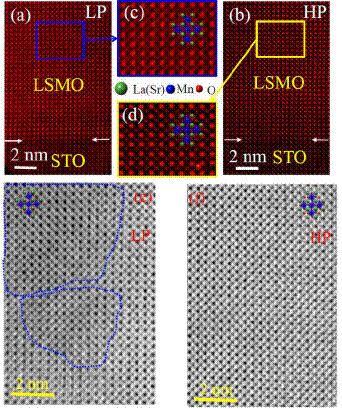| The origin of oxygen vacancies controlling La2/3Sr1/3MnO3 electronic and magnetic properties |
| From: PublishDate:2017-06-16 Hits: |
Oxygen vacancies play a crucial role in perovskite oxide thin films. Although there are many reports on the effects of the oxygen vacancies on the regulating the properties in the oxide thin films, however, the effects of the oxygen vacancies have not been clear yet. Clarifying the role of oxygen vacancies in manganite thin films is interesting not only for device applications but also for basic understanding of physical interactions in oxides. A cooperated team from Institute of Physics and Institute of High Energy Physics of Chinese Academy of Sciences has investigated the effect of the oxygen vacancies on the crystal structure and electronic structure of the oxide thin films. Their research has been published on March 7, 2016 in Advanced Materials Interfaces. La2/3Sr1/3MnO3 is a prototype material of the correlation system of perovksite oxides, and owns desirable tunable properties, such as ferromagnetic, metal, colossal magnetoresistance, and half-metallicity, etc. However, oxygen vacancies will be readily induced in perovskite oxide thin films during deposition, and will induce degraded magnetic and transport properties. To gain a deep insight in the roles of oxygen vacancies on regulating the atomic structure and electronic properties of the mixed-valence manganites, two high-quality epitaxial La2/3Sr1/3MnO3 films around a critical point (without/with oxygen vacancies) were designed and fabricated. The evolution of atomic structure and electron correlation in LSMO thin films with oxygen vacancies was investigated employing a combination of high-resolution synchrotron x-ray diffractometry, scanning transmission electron microscopy, x-ray photoemission, x-ray absorption spectroscopy, resonant x-ray photoemission spectroscopy, and band structure calculations, etc.
Figure 1. Atomically resolved HAADF images of (a) (c)LP and (b) (d) HP near the interface viewed along the [100] direction. It can be seen that the both interfaces of LP and HP are atomically sharp and coherent, without any evidence of misfit dislocations or chemical reaction in the interface region. Atomically resolved ABF images of (e) LP and (f) HP along the [100] direction. ABF image in (f) essentially appears defect-free in HP, showing uniform contrast and atom columns. However, there are some regions of accumulated strain in LP (the area showing different color contrast, fenced by the blue dotted lines in Figure 2(e)). These regions of accumulated strain should result from the presence of oxygen vacancies.
To examine the effect of the oxygen vacancies on the core-level and valence band electronic structures, X-ray absorption spectroscopy (XAS), x-ray photoelectron spectroscopy (XPS), x-ray magnetic circular dichroism (XMCD), and Mn 2p resonant photoemission spectroscopy (RPES) were performed on the beamlines of the Beijing Synchrotron Radiation Facility (BSRF) at the Institute of High Energy Physics, Chinese Academy of Sciences.
Figure 2. (Color online) (a) The Mn 3s XPS spectra for LP and HP, respectively. The energy separation between two Mn 3s peaks indicates ΔE3s. (b) The XAS spectra at the Mn L2,3 edge for LP and HP, respectively. Mn 2p-3d RPES spectra of (c) LP and (d) HP, respectively. The olive star indicates an obvious enhancement of the shoulder of the spectrum feature of LP. From the experiments and theoretical calculations, it was found that the oxygen vacancies induce a weakening of Mn-O-Mn hybridized bond and an increase of concentration of Mn3+ ions, impair the double exchange between Mn3+ and Mn4+, and therefore lead to the transition from metal to insulator and the degraded magnetic properties. Our finding demonstrates a practical approach to tune the magnetic and transport properties of oxide thin films by precisely controlling the oxygen vacancies for high performance spintronics applications.
Article: Haizhong Guo, Jia-ou Wang, Xu He, Zhenzhong Yang, Qinghua Zhang, Kui-juan Jin *, Ruiqiang Zhao, Lin Gu*, Yaqing Feng, Wenjia Zhou, Xiaolong Li, Qian Wan, Meng He, Chen Ge, Caihao Hong, Zhiying Guo, Can Wang, Huibin Lu, Ibrahim Kurash, Sheng Meng, Hao Yang, and Guozhen Yang, The origin of oxygen vacancies controlling La2/3Sr1/3MnO3 electronic and magnetic properties, Advanced Materials Interfaces 3, 1500753(2016). |
|
|
| Chinese
- Metal-free efficient photocatalyst for stable visible water splitting——Top ten major scientific progresses in China in 2015
- The nano-resolution imaging platform was awarded the first rate prize of Beijing Science and Technology in 2014
- Beamline 1W1 of BSRF started to runoperate in the couplingparasitic mode of BEPCII
- Synthesis of High Performance Polymer Materials for Field Effect-Transistors
- Surfactant molecular aggregates in green solvents
- GIXRD has played an important role in the characterization of organic thin-film transistors
Science Highlights
Home /
Copyright © 2011 - 2012 Beijing Synchrotron Radiation Facility



